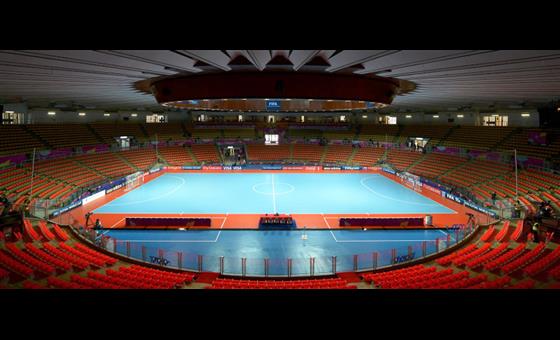Field
It is rectangular. The dimensions should be as follows: Length (touch line): min. 25m max. 42 m Width (goal line): min. 16 m max. 25 m.
The playground is smooth: a wooden surface preferably.
The penalty area is an arc of 6 metres in radius, starting from a number of goals
The penalty spot is at 6 metres away from midpoint the goal line
A second penalty spot is at 10 metres from midpoint the goal line
The radius of the corner arc is 25 cm
Goal posts are positioned midway the length of the field and are 3 metres wide and 2 metres high.
The substitution area is situated in front of the area reserve for technical staff; on on each side of the pitch occupied by the respective team
Ball
It is round, 62cm – 64cm in circumference, and weighs between 400g and 440g at the beginning of the game.
The ball can only bounce up to 65cm and not less than 50 cm when it is initially bounced from a 2m height.
During the game the ball cannot be replaced except by authorisation of the referees.
Players
All matches are contested by two teams composed of a maximum of five players each, among whom one will be the goalkeeper.
A game cannot begin if any of the two teams has less than three players. Also, the game will be ended if one of the teams happens to be left with less than three players on the playground.
An unlimited number of substitutions are allowed during the match but the rules of certain competitions could limit the number.
Substitutions can be done when the ball is being played and even when it is off the pitch.
The incoming player cannot enter the playground before the player he is replacing gets out of the field.
A substituted player can return to the field.
Any incoming player can be a substitute for the goalkeeper, without having to notify the referees and without having to stop to the game.
A player or substitute that becomes the goalkeeper has to put on the goalkeeper jersey carrying the player’s number.
However, the number of players that can replace the goalkeeper could be limited to a maximum of two under certain rules.
Equipment
A jersey, shorts, socks, shin guards and shoes. Only canvas shoes or soft leather sports shoes with rubber or similar sole materials are allowed.
Referees
Two referees officiate a game, a main referee and a second. In case of conflict over the decisions of the referees, the decisions of the main referee will trump over that of the second referee.
Two assistant referees could be assigned (a third referee and a time keeper). It will be so for the Futsal Africa Cup of Nations. They have to position themselves outside the field of play, on the side where the substitution zones are and near the median line.
The time keeper sits down at the chronometry table.
Game Periods
The game is played in two periods of 20 minutes each. The chronometer is stopped when the ball goes out of pitch.
The time keeper announces the end of each of the play times, a 20-minute duration, by a sound signal.
Half-time should not exceed 15 minutes. The rules of the competition should clearly define the duration.
The teams are entitled to a minute of injury time during each of the periods.
If a team does not claim its injury time during the first half, it might not equally have a second injury time during the second half.
Additional time has to be granted for every penalty shot-out, to be done at the end of one of regular play times or at the end of one of the prolongation periods.
The rules of a competition could make provision for a prolongation of two equal durations of 3 or 5 minutes each. As concerns the Futsal Africa Cup of Nations, it will be 2×3 minutes.
No injury time will be granted during extra time.
The rules of a competition can provide for a penalty shot-out session. Alternatively, the two teams will execute three shots each.
Each shot is done by a different player, and all authorised players must have kicked a first shot before any of them could kick a second.
Sanctions
The yellow card is used to indicate that a player or a substitute is warned.
The red card is used to indicate that a player or substitute is expelled.
Fowl plays are sanctioned with a direct free kick, a kick from the penalty area, or an indirect free kick.
Every player that was excluded must quit the vicinity of the playground, as well as the area reserved for technical staff.
Free kicks are either direct or indirect.
If the team executing a free kick takes more than four seconds to do so: an indirect free kick is granted to the opposing team at the spot where the game had to resume.
A goal cannot however be validated if the goalkeeper of the offending side intentionally throws or hits the ball with his hand or arm from his penalty area, and is the last player to touch the ball. In this case play will resume with a goal kick in favour of the defending side.
Ex- CAF Media Expert. An expert on African football with over 15 years experience ,always with an ear to the ground with indepth knowledge of the game. I have worked for top publications including 7 years at www.supersport.com until i founded www.soka25east.com to quench the thirst of football lovers across the continent. I have trained young upcoming journalists who are now a voice in African football.I have covered World Cup,AFCON,CHAN,Champions League,Confederations Cup,Cecafa,Cosafa,Wafu and many other football tournaments across the World. Founder Football Africa Arena(FAA),Founder www.afrisportdigital.com



CAF Confederation Cup
Simba book final spot in CAF Confederation cup
Must See
-


AFRICA
/ 5 years agoSierra Leone FA President Isha Johansen endorses Patrice Motsepe for CAF President
Sierra Leone FA President who also doubles up as CAF Executive Council member Madam...
-


Football
/ 5 years agoIT JUST CAN NOT BE – AN AFRICA FULL OF MORONS?
By John De Mathews, There is an eerie silence around Africa, and it is...














